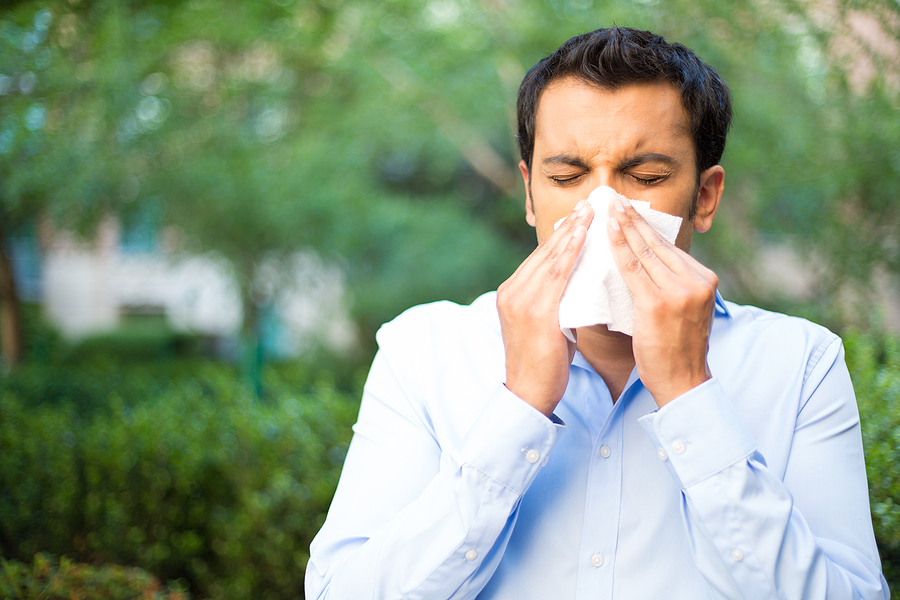
A nagging tickle in your throat has you coughing nonstop for hours and keeps you up all night. No matter how much you cough, you can’t seem to clear your throat. You’ve coughed so much your throat stings. Coughs may … Continue reading
READ MORE
The sun’s out more, it’s warming up, and gloomy rainy days are disappearing as the seasons change. Yet, you step outside and feel miserable. Your sinuses fill up. Your throat doesn’t feel right. Your eyes are itchy and watery. Spring allergies are a bummer, and you’re tired of having to hide inside. What can you do?
It’s time to say no more to your allergies and see a doctor for respiratory allergy testing. Find out what pollens are impacting how you feel. You don’t have to live in misery anymore. Take a closer look at allergy testing and treatment options.
Over 100 million Americans experience some form of allergy each year. It breaks down to 33% of adults and 25% of children. The three most common allergies reported in these adults and kids are:
Here are a few more surprising facts about allergies.
Did you know that you can have more than one type of allergy? I can attest to that as birch, pine, and poplar tree pollen affect me each spring. I also have a less common allergy to lettuce, as well as latex and nickel allergies. Finding what you’re allergic to takes time, and it makes a huge difference if you make an appointment and work with an allergy doctor to find the best allergy treatments.
Those facts cover all allergies, but spring allergies often impact the respiratory tract more than your skin, digestive tract, etc. Respiratory allergy testing is an important step in this if your seasonal allergies trigger respiratory symptoms like:
Respiratory allergies occur when you breathe in an allergen, triggering an allergic reaction in the nasal passage, throat, and lungs. Some of the common springtime triggers of respiratory allergies include:
When you see an allergy doctor, there are different allergy tests available. Skin tests are one of the most common. Small drops of allergens are placed on our skin and pricked with a small lancet to push the allergen into the top skin layers. You’re monitored for signs of an allergic reaction, such as itchy raised bumps called wheals.
Before a skin prick test, you cannot take allergy medications for at least 72 hours. Be prepared to stop using it around three days before your appointment.
Your skin is carefully washed with soap and water or alcohol. Marker is then used to mark each allergen applied to your skin, often on your forearm. After the marks are made about two centimeters apart, the allergen is applied and a lancet is used to scratch the skin, allowing the allergen to get into the layers of skin. Each allergen requires a new lancet. Up to 25 allergens can be tested at once.
Next, you wait about 20 minutes to see if any wheals appear. That helps determine which allergens trigger your immune system. Wheals are graded by size, starting at four millimeters and going up to 15 or higher. Larger wheals make it clear that there’s a reaction Wheals less than five millimeters indicate there is no allergy.
Intradermal allergy testing is another option. It’s similar, but the allergen is in a needle. It’s injected under the skin. You then wait up to 40 minutes for the test to complete, though the reaction is often apparent after 15 minutes.
The chance of a false positive is there. That’s why it’s essential that you see an allergy doctor versus any DIY home test.
Once you know your respiratory allergy triggers, you can work with your allergy doctor on the best treatments. Over-the-counter medications, allergy shots, and avoidance are the most common options for springtime allergies.
Staying away from your allergen. If your test results show you have a pet dander allergy, you may want to consider keeping your home pet-free. If you’re allergic to pine pollen, keeping your windows closed and limiting time outside are options.
Over-the-counter antihistamines and decongestants can help with mild allergies. If yours are severe, prescription medications may be better.
Immunotherapy takes time, but it’s a more permanent option. You go for allergy shots each week or so for several years. Slowly, over time, your body builds up a healthier response to allergens, which eases your symptoms permanently.
There are newer allergy shots that work faster, but they’re given in your lymph nodes. You go for three allergy shots a month apart. An ultrasound is needed to ensure proper placement of the needle.
If you hate needles or struggle to find time to get to the doctor’s office, sublingual (SLIT) treatments are ideal. Instead of shots, you place a dissolvable tablet or drops under your tongue each day. You work with an allergist first to get the dose correct and then take care of the administration of the drops or tablets at home when it’s convenient for you.
Any appointment with a doctor can be stressful. You don’t know what to expect or how much discomfort you face. It’s not as bad as you may think. Our recommendation for a stress-free appointment starts with being prepared. Have information available. Keep a journal or write out:
During the appointment, you’ll be asked about your family’s medical history and your own. Provide as much information as you can. Once these questions are answered, your allergy doctor will listen to your lungs and look at your nose and throat.
If allergies are suspected, your allergy doctor will recommend allergy tests. These are important when it comes to determining the allergens that affect you. The allergy test may be scheduled for another day. If there’s time, you might have them done during this appointment.
Once the results are ready, you’ll discuss treatment options. You may need to try a couple of approaches to find the best one to get you through spring allergies.
Make an appointment with Premium Allergy & Respiratory Center to get started. The online appointment scheduler is available for your new patient visit and all follow-up care, including allergy shots.